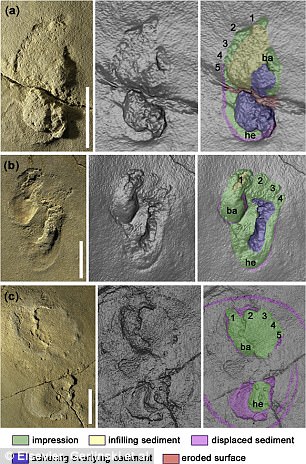The mystery trail of 5.7 million year old fossilised footprints in Greece that could shake up our understanding of human evolution
Researchers have discovered 5.7 million-year-old human-like footprints in Crete
But, at this time, it's thought human ancestors were in Africa, with ape-like feet
The find suggests a previously unknown species may have existed in Europe
And, it suggests this early primate convergently evolved human-like feet
A trail of 5.7 million-year-old fossil footprints discovered in Crete could upend the widely accepted theories on early human evolution. The new prints have a distinctly human-like form, with a similar big toe to our own and a ‘ball’ in the sole that’s not found in apes
‘What makes this controversial is the age and location of the prints,’ says Professor Per Ahlberg at Uppsala University, one of the authors on the new study.
Studies in recent decades have led to the conclusion that all fossil human-ancestors older than 1.8 million years lived and evolved in Africa.
The new fossil footprints are not the oldest hominin evidence to be found, but they could drive a wedge in the timeline of evolution.
It’s thought that human ancestors of the last few million years directly derived from a genus known as Ardipithecus.
And, as a set of ‘reasonably complete’ 4.4 million-year-old Ardipithecus ramidus fossils discovered in Ethiopia was found to have an ape-like foot, it was thought that the human-like foot had not yet evolved by that time.
Several other fossil discoveries in South and East Africa have further supported the idea that the evolution of human bipedalism took place on the continent, including the 3.7 million-year-old Laetoli footprints from Tanzania, which provide evidence of human-like feet and upright locomotion.
According to the new study, however, the new footprints discovered in Trachilos have an ‘unmistakably human-like form.’
THE NEW PRINTS
The prints were found in a type of sedimentary rock that formed when the Mediterranean Sea briefly dried out, 5.6 million years ago.
This knowledge, coupled with dating methods based on marine microfossils, indicates that the prints are about 5.7 million years old.
The shape of the fossil prints suggests the suspected hominin who left them was more primitive than the Laetoli, whose 3.7 million-year-old prints found in Tanzania gave evidence of human-like feet and upright locomotion.
The new footprint is proportionately shorter, though it shares the same general form.
While the Trachilos prints were created on the sandy shore of the Mediterranean, the Laetoli tracks were made in volcanic ash.
The researchers now say that during this time, before modern day Crete detached from the Greek mainland or the Sahara Desert even existed, early hominins could have lived across southeast Europe as well as Africa.
The new fossil footprints are not the oldest hominin evidence to be found, but they could drive a wedge in the timeline of evolution. The researchers say both the location and the age of the prints are controversial
‘The interpretation of these footprints is potentially controversial,’ the authors wrote in the study, published to the journal Proceedings of the Geologists’ Association.
‘The print morphology suggests that the trackmaker was a basal member of the clade Hominini, but as Crete is some distance outside the known geographical range of pre-Pleistocene hominins we must also entertain the possibility that they represent a hitherto unknown late Miocene primate that convergently evolved human-like foot anatomy.’
The prints were found in a type of sedimentary rock that formed when the Mediterranean Sea briefly dried out, 5.6 million years ago.
COMPLEX EVOLUTION OF MAN
55 million years ago - First primitive primates evolve
15 million years ago - Hominidae (great apes) evolve from the ancestors of the gibbon
8 million years ago - First gorillas evolve. Later, chimp and human lineages diverge
5.5 million years ago - Ardipithecus, early 'proto-human' shares traits with chimps and gorillas
4 million years ago - Ape like early humans, the Australopithecines appeared. They had brains no larger than a chimpanzee's but other more human like features
3.9-2.9 million years ago - Australoipithecus afarensis lived in Africa.
2.7 million years ago - Paranthropus, lived in woods and had massive jaws for chewing
2.3 million years ago - Homo habalis first thought to have appeared in Africa
1.85 million years ago - First 'modern' hand emerges
1.8 million years ago - Homo ergaster begins to appear in fossil record
1.6 million years ago - Hand axes become the first major technological innovation
800,000 years ago - Early humans control fire and create hearths. Brain size increases rapidly
400,000 years ago - Neanderthals first begin to appear and spread across Europe and Asia
200,000 years ago - Homo sapiens - modern humans - appear in Africa
40,000 years ago - Modern humans reach Europe
This knowledge, coupled with dating methods based on marine microfossils, indicates that the prints are about 5.7 million years old.
The best-preserved prints are shown above, alongside 3D scans
The shape of the fossil prints suggests the suspected hominin who left them was more primitive than the Laetoli.
The foot is proportionately shorter, though it shares the same general form.
While the Trachilos prints were created on the sandy shore of the Mediterranean, the Laetoli tracks were made in volcanic ash.
The researchers now say that during this time, before modern day Crete detached from the Greek mainland or the Sahara Desert even existed, early hominins could have lived across southeast Europe as well as Africa.
‘This discovery challenges the established narrative of early human evolution head-on and is likely to generate a lot of debate,’ said Per Ahlberg.
‘Whether the human origins research community will accept fossil footprints as conclusive evidence of the presence of hominins in the Miocene of Crete remains to be seen.’
According to the study, the new footprints discovered in Trachilos have an ‘unmistakably human-like form.’ But, they were created during a time when it’s thought early human ancestors were still in Africa – and, when they still had ape-like feet
Source: https://www.dailymail.co.uk/sciencetech/article-4844832/Fossil-footprints-shake-human-evolution-timeline.html












